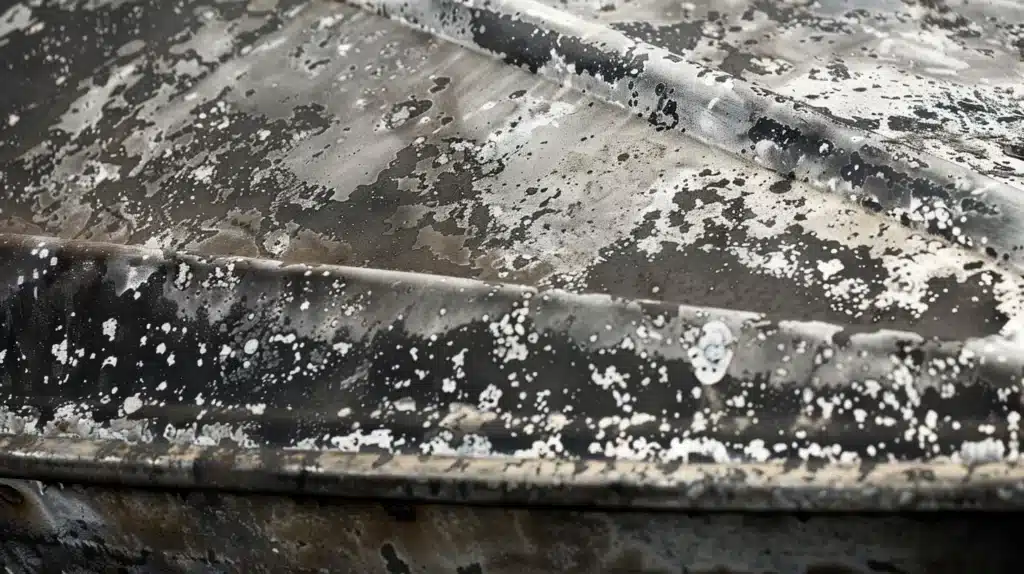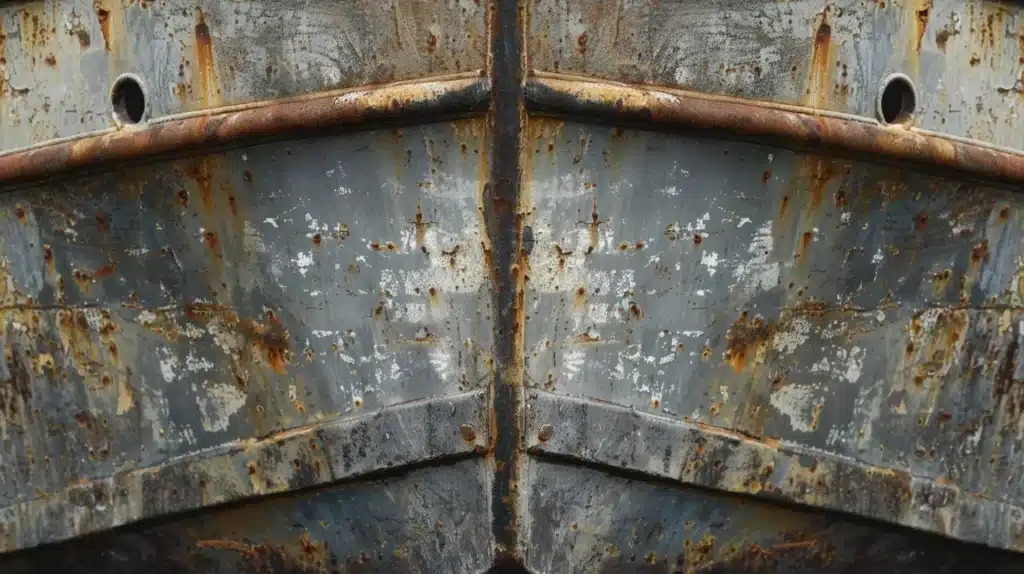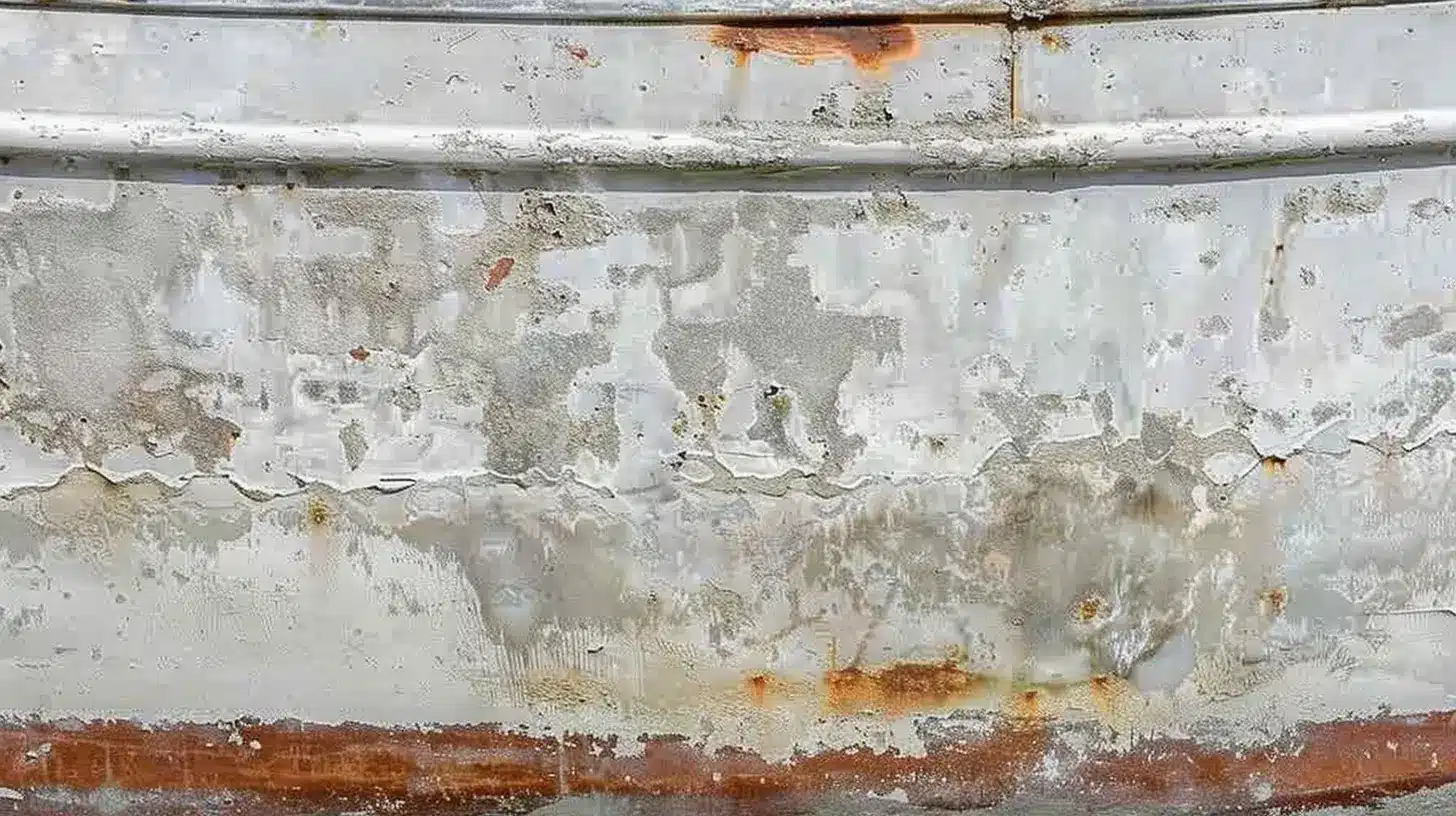Have you ever noticed a powdery white substance on your aluminum hull and wondered what it could be?
The presence of this white powder is a common sign of oxidation on aluminum hulls, signaling the formation of aluminum hydroxide and aluminum oxide.
Interested to learn more? Have a look at our article that explains what is aluminum oxidation?
But what does this mean for the integrity of your hull?
Understanding the implications of this visible sign of oxidation is crucial for maintaining the health and longevity of your aluminum hull.
Key Takeaways
- White powdery residue and dull patches are visible signs of oxidation on aluminum hulls.
- Exposure to water, air, lack of protective coating, saltwater, and pollutants can contribute to aluminum hull oxidation.
- Regular cleaning, applying protective coatings, and utilizing specialized products like aluminum brightener and cleaner and aluminum acid wash are key steps to prevent and treat aluminum hull oxidation.
- Neglecting oxidation can lead to diminished structural strength, corrosion, and reduced lifespan of the boat.
This how to clean aluminum article can give you a more detailed idea.
1. Understanding Oxidation on Aluminum Hulls

If you notice a white powdery residue on your aluminum hull, it’s a visible indication of oxidation. Aluminum hull maintenance is crucial to prevent the detrimental effects of oxidation.
When aluminum oxidizes, it forms a protective coating that shields the metal from further exposure to oxygen, effectively safeguarding the hull.
However, if this protective layer is compromised due to factors such as exposure to water and air, lack of protective coating, or environmental elements like salt water and pollutants, it can lead to corrosion.
The natural oxidation process, along with the age and condition of the hull, also contribute to the formation of this white powdery residue.
Regular cleaning and maintenance, along with the use of products like 3M aluminum cleaner, acid-based cleaners, SOS pads, and car wax spray, are effective methods for cleaning oxidized aluminum hulls.
As a leading chemical manufacturer, we recommend products, like acid-based cleaners, SOS pads, and car wax spray for cleaning oxidized aluminum hulls, and our pressure washing chemicals to ensure deep and effective cleaning.
2. Visual Signs of Aluminum Hull Oxidation

Examine the visible signs of aluminum hull oxidation to accurately assess the protective condition of your vessel’s metal surface. The causes of aluminum hull oxidation, such as exposure to air and water, can lead to several visual indicators.
First, look for white powder accumulation, as oxidation often leaves behind a noticeable powdery substance on the metal. This accumulation is a clear sign of oxidation.
Additionally, pay attention to the hull’s appearance. Dullness and lackluster patches suggest that the aluminum has undergone oxidation. The formation of a chalky substance on the hull’s surface is another visible sign, indicating a chemical reaction with oxygen.
Corrosion spots, resembling frost stars, may cover the hull from the waterline down, indicating localized oxidation. Differences in appearance above and below the waterline can also be observed, with smaller or non-existent corrosion spots above the waterline suggesting the influence of water exposure on aluminum oxidation.
If left untreated, the effects of aluminum hull oxidation can lead to further deterioration of the metal, potentially compromising the structural integrity of the hull and necessitating costly repairs.
3. Factors Contributing to Aluminum Hull Oxidation
Factors contributing to aluminum hull oxidation include environmental conditions, such as saltwater exposure and pollutants, as well as the age and condition of the hull.
Saltwater, in particular, has a significant impact on the oxidation of aluminum hulls. When aluminum comes into contact with salt water, it creates an electrolytic environment that promotes the oxidation process.
The chloride ions in saltwater accelerate the formation of aluminum oxide, which is the primary component of the protective layer on aluminum.
However, this process can also lead to pitting and corrosion of the aluminum surface if not properly managed.
Therefore, it’s crucial to implement corrosion prevention measures to mitigate the effects of saltwater exposure.
Regular cleaning and protective coatings can help minimize the detrimental effects of saltwater on aluminum hulls.
Additionally, proper maintenance and timely repairs are essential to ensure that the hull remains in good condition and resistant to oxidation, especially when exposed to saltwater and other corrosive elements.
4. Preventing and Treating Aluminum Hull Oxidation
To effectively prevent and treat aluminum hull oxidation, it’s essential to implement a regular cleaning regimen and apply protective coatings to the boat’s surface. Here are some key steps to prevent and treat aluminum hull oxidation:
- Regular Cleaning: Rinse and clean the boat regularly to remove salt, dirt, and pollutants that accelerate oxidation due to oxygen exposure. For this purpose, our degreasers can be extremely helpful.
- Application of Protective Coatings: Apply a high-quality wax or protective coating to the boat’s surface to create a barrier against oxygen exposure and prevent oxidation.
- Buffing and Waxing: Buff the boat’s surface to remove the chalky substance caused by oxidation, and then apply wax for protection against corrosion.
- Use of Specialized Products: Utilize specialized products, like our aluminum brightener and cleaner and aluminum acid wash designed to effectively remove oxidation and treat the boat, ensuring thorough protection against the damaging effects of oxidation…
5. Importance of Addressing Aluminum Hull Oxidation
Addressing aluminum hull oxidation is essential for maintaining the structural integrity and aesthetic appeal of the boat. Neglecting oxidation can lead to severe consequences.
The impact of neglecting aluminum hull oxidation includes diminished structural strength, compromised safety, and reduced lifespan of the boat.
Oxidation weakens the aluminum, making it susceptible to corrosion, pitting, and ultimately structural failure.
Furthermore, the accumulation of oxidation can result in a rough, unappealing surface, detracting from the boat’s visual appeal and potentially lowering its resale value.
Therefore, it’s imperative to prioritize regular maintenance and cleaning to prevent oxidation from taking hold. Best practices for aluminum hull maintenance involve implementing a routine cleaning schedule, applying protective coatings such as anti-fouling paint, and promptly addressing any signs of oxidation.
6. Frequently Asked Questions
1. How Do You Check the Mechanical Condition of a Boat?
To check the mechanical condition of a boat, inspect the hull for signs of oxidation, evaluate the engine and propeller for damage, test the steering and control systems, examine electrical components, and assess essential safety equipment.
2. What Is the Best Way to Clean the Hull to Protect the Environment?
To protect the environment while maintaining your aluminum hull, opt for eco-friendly cleaning products. Regular hull maintenance including buffing and waxing can prevent oxidation, ensuring a clean hull without harming marine conservation efforts.
3. What Should You Do if Your Pleasure Craft Has Mechanical Problems?
If your pleasure craft has mechanical problems, follow emergency procedures and safety precautions. Stay calm, assess the situation, and take appropriate action. Ensure everyone on board is safe, and seek professional assistance if needed.
4. When Should a Pleasure Craft Operator Check That the Boat Is in Good Working Order?
When should you check your pleasure craft? Before every trip, inspect safety equipment and fuel consumption. Regularly assess engine, electrical systems, and structure, especially after rough weather or impacts. At season end, conduct comprehensive maintenance to address wear and tear.
7. Conclusion
So, now you know that the presence of a white powder on aluminum hulls is a clear sign of oxidation.
If you still have questions, check out our blog post on how to clean aluminum oxidation
Just like how a red flag signals danger, the sight of this white powder should prompt you to take action to prevent further damage to your aluminum hull.
Keep an eye out for this visual cue and address any oxidation promptly to protect your boat’s hull. For more tips on maintaining your aluminum hull, refer to our article on how to polish aluminum.



